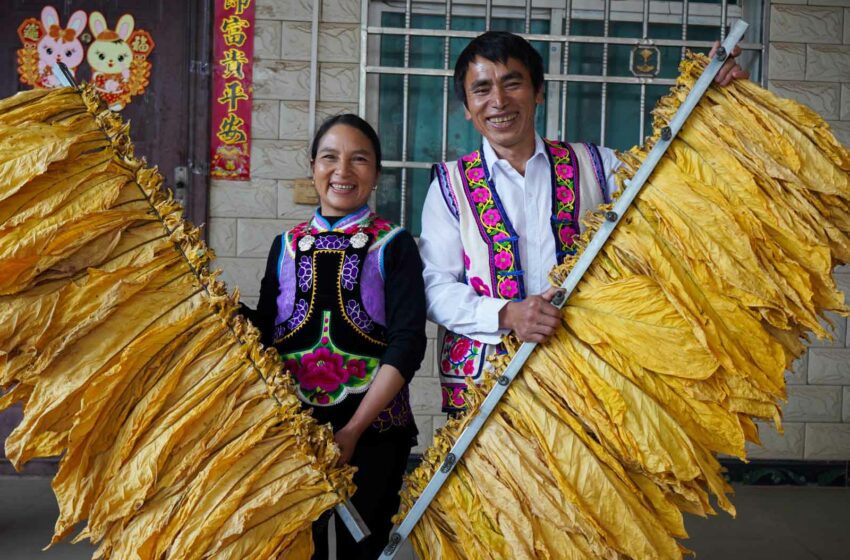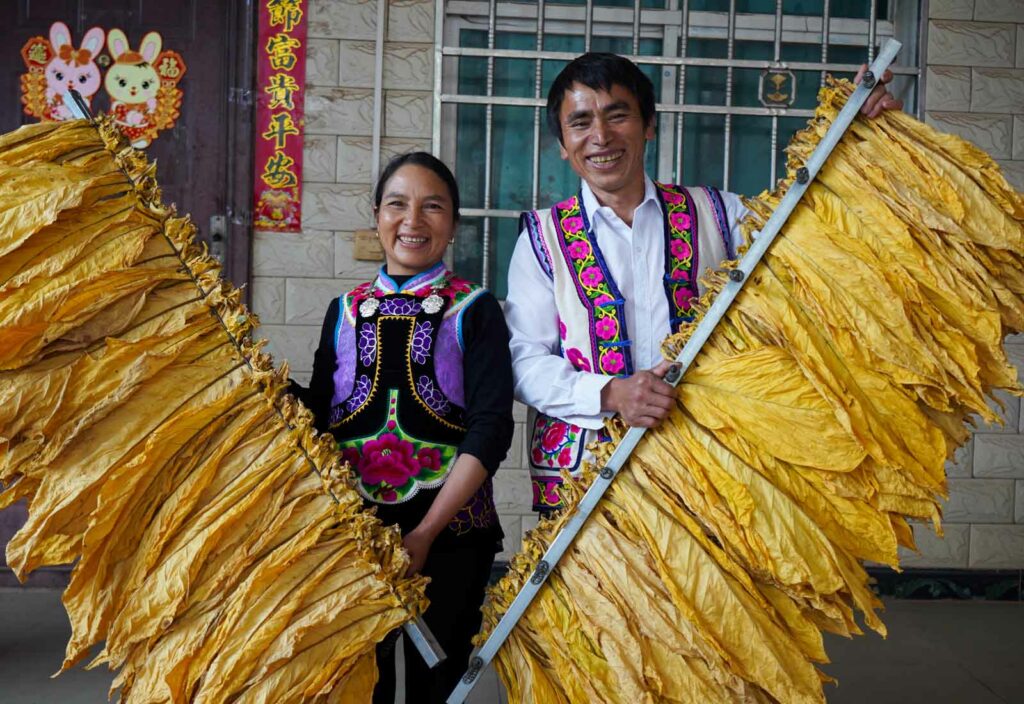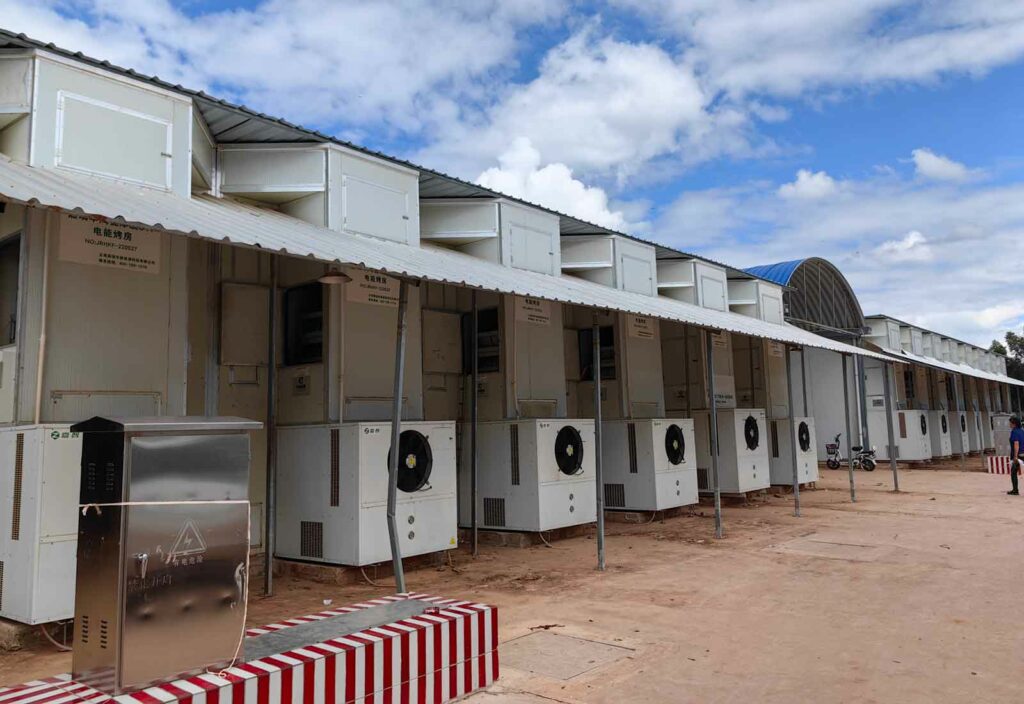A Greener Leaf
- Also in TR Featured News This Week
- January 15, 2024
- 0
- 8 minutes read


(Photos: Jingmei Zhang)
Chuxiong tobacco flue-curing enters the “zero carbon” era.
By Min Lu, Xiaojiao Du, Jingmei Zhang
Tobacco flue-curing is a critical tobacco production procedure and a relatively concentrated carbon emission process. By reducing carbon emissions during flue-curing, green production of flue-cured tobacco would be achieved. China is striving to achieve carbon neutrality by 2060 based on its responsibility to promote a shared future for mankind and its inherent requirements for achieving sustainable development. Under the “carbon peak and neutrality strategy,” the green and low-carbon transformation of the tobacco industry is imminent. China Tobacco proposes to accelerate the green and low-carbon transformation of the industry’s development mode, focusing on the green development goals outlined in the next five-year plan. This initiative aims to expedite promoting green tobacco agriculture and facilitate the overall low-carbon transformation and upgrading of the entire industrial supply chain.
The Chuxiong region has a long history of cultivating flue-cured tobacco. As early as 1613, tobacco was successfully grown in Wuding and Lufeng counties, which was then known as CaoYan. This area was among the earliest tobacco-planting regions in Yunnan. Today, Chuxiong has emerged as the second-largest tobacco-producing area in the province, supporting the economic and social development and contributing significantly to the increase in the Yi nationality people’s income.
Situated in the central northern part of Yunnan Province, Chuxiong Yi Nationality Autonomous Prefecture is located on an inland plateau, with over 90 percent of its total area covered by mountains and semi-mountainous terrain. The region experiences a subtropical low-latitude plateau monsoon climate, providing an ideal geographical environment and climate conditions for cultivation of flue-cured tobacco. With its picturesque landscapes and favorable ecological advantages, Chuxiong Prefecture stands out as one of the most scenic tobacco-producing areas in Yunnan.

In recent years, Chuxiong Tobacco Co. has actively developed new energy electric flue-curing barns. In order to reduce the energy cost of electric flue-curing barns, solar power technology has been used to find clean energy for tobacco leaf flue-curing while also possessing the function of cold and freezing storage. Chuxiong Prefecture has taken a pioneering step toward “zero carbon” flue-curing in the province, aiming to reduce environmental impact significantly.

At present, coal has been the primary energy source for tobacco leaf flue-curing in Chuxiong Prefecture, leading to high energy consumption and inefficiency. Coal combustion has high carbon emissions, contributing to environmental pollution. Additionally, coal-fired flue-curing barns often lack precise temperature and humidity control, leading to issues such as rapid heating, temperature fluctuations and damage to tobacco leaves during flue-curing. These challenges have hindered the long-term development of green tobacco production, making the transition to clean and renewable energy sources imperative.
Chuxiong boasts abundant sunshine, with an average annual sunshine duration of 2,447 hours and an average daily sunshine duration of 6.7 hours, making it one of the best areas for solar energy technology. The local government, particularly in Gonghe Town, Mouding County, has proactively sought funding to explore the construction of photovoltaic power stations atop 300 electric flue-curing barns in the region. This initiative converts solar energy into electricity, contributing to the reduction of carbon emissions and promoting sustainable energy practices. For example, a photovoltaic power station has been built on the roof of the 60 electric flue-curing barns of the Tiantai Village in Gonghe Town, with an installed capacity of 1,076 kW, 1,957 photovoltaic panels and an average annual power generation of 1,506,400 kWh. Based on full grid connection, the average annual income would be CNY505,849 ($70,933).

Gonghe Town has also innovatively transformed electric barns into multifunctional units suitable for local conditions. Refrigeration equipment has been installed in 36 electric barns, enabling them to serve as cold and freezing storage units after the tobacco leaf flue-curing season. This comprehensive use of resources not only increases the efficiency of the barns but also supports the planning and development of nontobacco industries in the region—for example, to provide for keeping fresh conditions for planting green peas and green broad beans.
To enhance flue-curing management practices, Chuxiong Tobacco has developed an Internet of Things (IoT) hardware device for flue-curing barns. Leveraging IoT technology, flue-curing technicians can monitor flue-curing conditions in real time through their mobile phones. They can adjust parameters, such as dry bulb and wet bulb temperature, providing precise guidance and real-time monitoring. By the end of 2022, the IoT hardware equipment had been successfully implemented across 4,894 barns, connecting them to the smart flue-curing management system.
After the completion of the electric energy flue-curing barn, Chuxiong Tobacco Co. strengthened the training of the tobacco leaf flue-curing team, focusing on the electric energy flue-curing barn’s technology. Flue-curing technicians initially faced challenges in understanding the debugging and use techniques of the electric flue-curing barn. To address this, Chuxiong Tobacco organized multiple training sessions to enhance the team’s proficiency in operating the electric flue-curing barn and improving flue-curing technology.
Starting from early August 2023, a comprehensive benefit analysis was conducted on three types of flue-curing barns: electric, biomass and coal. Through their own experiments, tobacco farmers gained firsthand insights into the advantages of electric flue-curing barns. A total of 38 flue-curing tests were conducted. From an economic perspective, the analysis revealed three key points.
First, the flue-curing cost, including electricity and labor, for the electric energy flue-curing barn was CNY1.60 per kilogram, significantly lower than the biomass flue-curing barn (CNY2.60 per kilogram) and the coal-fired flue-curing barn (CNY3.30 per kilogram). The electric energy flue-curing barn reduced costs by 66.5 percent and 109.5 percent compared to biomass and coal-fired options, respectively.
Second, the flue-curing loss rate was also analyzed. Electric energy flue-curing barns demonstrated a loss rate of 4.88 percent, outperforming biomass flue-curing barns (5.16 percent) and coal-fired flue-curing barns (5.8 percent). The electric energy flue-curing barn reduced quality flue-cured leaf losses by 5.7 percent and 19 percent compared to biomass and coal-fired alternatives.
Third, the flue-curing output value was considered. Electric energy barns were priced at an average of CNY31.16 per kilogram, surpassing biomass barns (CNY30.5 per kilogram) and coal-fired barns (CNY29.10 per kilogram). Electric energy barns saw a price increase of 2.23 percent compared to biomass and 6.75 percent compared to coal-fired barns.
Overall, electric flue-curing barns significantly lowered flue-curing costs, reduced flue-cured leaf losses and improved tobacco quality compared to biomass and coal-fired alternatives. Furthermore, the comprehensive output value of electric flue-curing barns increased by CNY2,890.30 per furnace and CNY4,535.20 per furnace, respectively (calculated based on a single furnace of 650 kg of dry tobacco), in comparison to biomass and coal-fired options. There has been a significant improvement in the economic benefits of 3,030 electric flue-curing barns in the state compared to coal-fired flue-curing barns.
In terms of ecological and environmental benefits, the operation of the electric energy flue-curing barn has achieved the goal of “zero carbon” emissions, marking a significant step toward green and sustainable development. Alliance One International, Philip Morris International and PwC Price Waterhouse Coopers visited Chuxiong Prefecture to inspect and study the construction of electric energy barns. They highly praised and fully recognized this innovative approach. Chuxiong Tobacco Co. has successfully navigated the challenges of clean energy flue-curing, leading the industry toward “intelligent flue-curing.” This innovation has established a new service model for “intelligent flue-curing” and also promoted green and sustainable development in tobacco-growing areas. More importantly, it has increased the income of tobacco farmers, consolidated achievements in poverty alleviation and contributed significantly to rural revitalization efforts.
